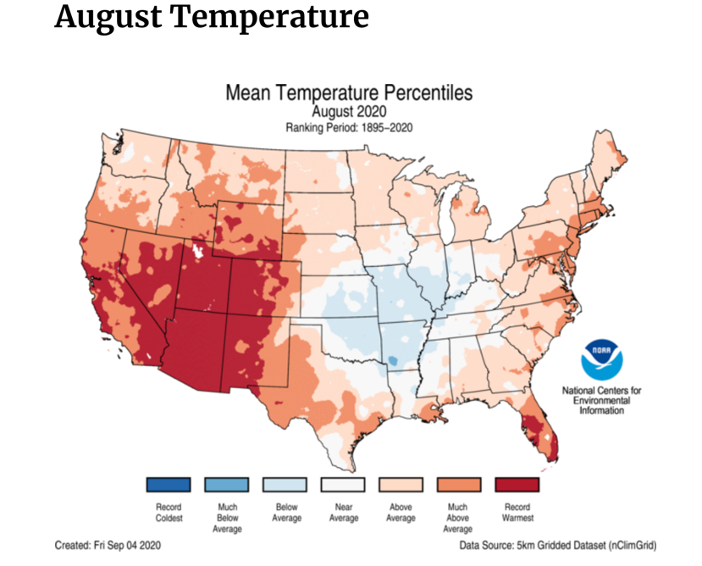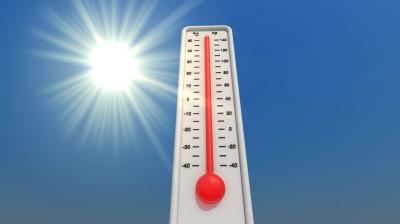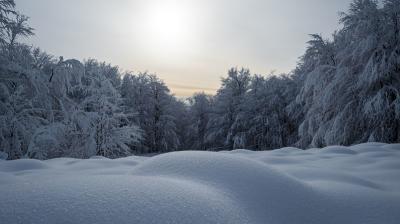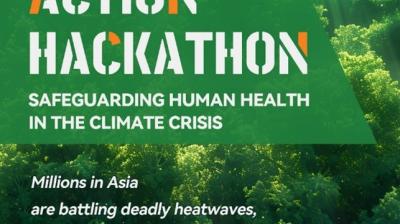Northern hemisphere summer marked by heat and fires

The Northern hemisphere just had its hottest summer and hottest August on record, according to the US National Oceanic and Atmospheric Administration.
At global level, it was the second warmest August on record and 0.94°C (1.69°F) above the 20th-century average of 15.6°C (1.69°F), according to the NOAA dataset. The Copernicus Climate Change Service implemented by the European Centre for Medium-Range Weather Forecasts ranked it as the fourth warmest August on record globally. WMO consolidates different international datasets for its reports on the state of the global climate.

August 2020 marked the 44th consecutive August and the 428th consecutive month with temperatures, at least nominally, above the 20th-century average. The 10 warmest Augusts have all occurred since 1998. The five warmest Augusts have occurred since 2015, according to NOAA.
The most notable temperature departures from average during August 2020 included the western contiguous United States, which is suffering a destructive fire season.
Record-breaking fires
The states of California, Oregon and Washington have been worst hit, with dozens of casualties, razing entire neighbourhoods to the ground and forcing the evacuation of thousands of people.
As of 13 September, nearly 16,500 firefighters continue working to gain containment on the 28 major wildfires across California. Since the beginning of the year, wildfires have burned over 3.2 million acres in California. Since August 15, when California’s fire activity elevated, there have been 24 fatalities and over 4,200 structures destroyed, according to Cal Fire.
The fires have impacted air quality for millions of people and turned skies orange. Clouds of smoke have billowed over the western Pacific and Atlantic.
Data from the Copernicus Atmosphere Monitoring Service (CAMS), implemented by the European Centre for Medium-Range Weather Forecasts on behalf of the European Commission, reveal that the wildfires he Western United States are significantly more intense than the 2003-2019 average for the whole country. CAMS, which monitors daily wildfire activity worldwide using satellite observations of their intensity to estimate emissions of atmospheric pollutants, has tracked the long-range transport of the smoke as far as 8,000 kilometres away to reach Northern Europe. The fires burning in California since mid-August, and in Oregon and Washington since the beginning of September, have emitted vast quantities of thick smoke that have affected a huge area. The fires emitted an estimated 21,7 megatonnes of carbon in California, 7,3 megatonnes of carbon in Oregon and 1,4 megatonnes of carbon in Washington. Overall emissions for Western USA were up to estimated 30,3 megatonnes of carbon.
Causes
According to th

Weather, climate and water-related conditions were also conducive to rapid wildfire growth.
Drought: The western United States has seen an expansion of drought conditions over the first half of 2020. In August, the dry conditions and high temperatures continued and worsened drought across the West. The percent area of the contiguous United States experiencing some level of drought increased by 7 percentage points in August, leaving nearly 40% of the country in drought.
Heatwave: A record-breaking heatwave settled over the Western USA during the middle of August. Temperatures soared to a recorded 54.4°C (130°F) in Death Valley, California. A WMO team of experts will verify this temperature reading.
Strong winds fed off the heat and low humidity and fanned the flames.

Connection to climate change
Six of the top 20 largest wildfires in California history have occurred this year, according to Cal Fire. In Cal-Fire’s list of the top twenty largest wildfires, eight of the top ten have occurred in the last ten years, and seventeen of the top twenty have occurred since 2000. Seven of the top ten most destructive wildfires have occurred since 2015.
Wildfires are a part of the natural cycle of life in many ecosystems across the western United States. As a fire blazes, it kills pests, while germinating a generation of new seedlings, and the forest growth cycle begins anew. But too many wildfires potentially permanently altering the ecosystem.
The Fourth National Climate Assessment, a US government inter-agency report, notes that from 1984 to 2015, climate change led to twice as much land being burned than if climate change had not occurred. And even though there are other factors involved in the acreage wildfires burn—like fire suppression and local fire management practices—from 1916 to 2003, the area burned by wildfires was likely also driven by climate factors.
According to the Fourth National Climate Assessment, climate change has led to more intense droughts, especially across California. These droughts, combined with increased temperatures, have desiccated forests, making them tinderboxes.
The report said that the 2011–2015 meteorological drought in California, combined with future warming, will lead to long-term changes in land cover, leading to increased probability of climate feedbacks (e.g., drought and wildfire) and in ecosystem shifts.
- WMO Member:
- United States of America










